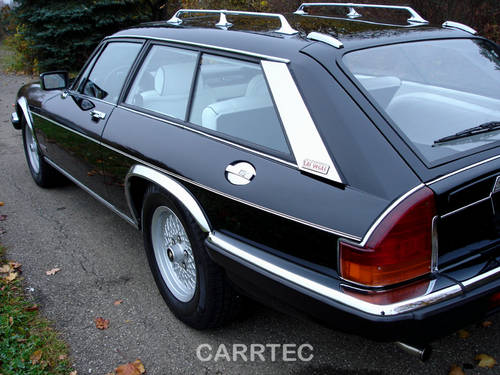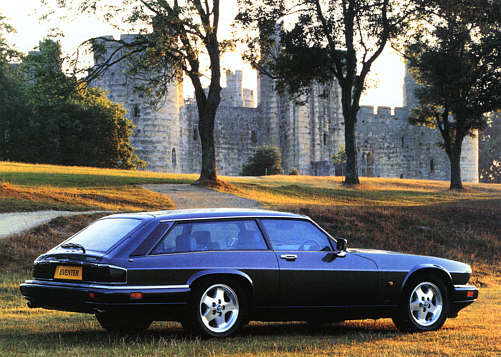By the mid-1970s, the Jaguar E-Type was getting a bit long in the tooth, despite several facelifts, upgrades, and the addition of a 5.3L V12 engine. Consumers were demanding something more up-to-date, so in 1975 Jaguar responded with the XJ-S Coupe. The legendary E-Type was a tough act to follow, and instead of a two-seat sports car, the XJ-S was a fully-fledged, four-seat Grand Tourer.
Although the XJ-S was designed and promoted as a four-seater, space was in reality fairly slim. What was one to do if one wanted more flexibility and more luggage space? The only variant of the XJ-S on the horizon was the Convertible, so come 1982, enter Lynx with their Eventer.
Lynx, founded in 1968, had been working with Jaguar products for years, including creating their own version of the legendary D-Type. With each car built to a customer’s exact specification, and taking up to 14 weeks to complete by hand, it may be little wonder that only about 67 Eventers were built. However, because they could be modified from either a brand new XJ-S, or a customer’s existing vehicle, each variant of XJ-S had at least one example of Eventer built. Although most used the familiar V12, there were also 6-cylinder versions and even the XJR-S. In 1992, the updated XJS was launched, and shortly thereafter came the updated Eventer.
Although XJS production ended in 1995 after nearly 20 years, the final Eventer wasn’t completed until 2002. Now, most are in the hands of (possibly eccentric) collectors, but if you’re looking for a performance vehicle with true grand touring capability, you can’t do much better than this.
Images courtesy Jaguar and CARRTEC, who are currently selling the beautiful 1987 Eventer pictured above, with only 4840km!
By 1994, Jaguar’s XJ-series cars had been in production for 8 years and were looking dated. In an effort to recapture the beauty of the original XJ6 of the 1960s, Jaguar’s XJ range was completely restyled for 1995, and the new styling was lauded as a resurgence of Jaguar elegance. As before, Jaguar manufactured Daimler-branded versions of its XJ saloons.
However, 1996 was Daimler’s centenary, and it was felt that something special should be done in celebration. Thus the Corsica was born: a 2-door convertible version of the Daimler Six saloon.
Built using an XJ-series body shell, and modified XJS and XK8 seating and roof mechanisms, the Corsica was built as a shell only, not a driveable vehicle, being intended only for display on motor show stands.
After Daimler’s centenary celebration, the vehicle was transferred to the Jaguar Daimler Heritage Trust, an offshoot of the manufacturer whose goal is to preserve important vehicles in both companies’ histories. Rather excitingly, the JDHT decided the Corsica deserved better, and commissioned David Marks Garages to turn an empty shell of a vehicle into a fully-functioning, running car. Some 400 hours of work later, the car was fitted with a complete powertrain, as well as all necessary electronics and HVAC systems.
The Corsica remains in the collection of the Jaguar Daimler Heritage Trust. Amongst other services, the JDHT operate a museum of important Jaguar and Daimler vehicles in Coventry. The collection is displayed on rotation, however, so if you’re hankering to see the Corsica in person, make sure you contact them first.
To read more about the incredible amount of work that went into rebuilding this beautiful car, check out the David Marks Garages story on the Daimler Corsica Project.
Images courtesy David Marks Garages and JDHT.
By 1997, the Bentley Turbo R had been in production for 12 years, and its body style dated back 4 further years. While awaiting the launch of the all-new Arnage in 1999, Bentley bridged the gap by creating the Turbo RT, using newer technologies first seen on the Continental T. Although only around 250 Turbo RTs were built, that model alone isn’t rare enough for inclusion here.
In 1998, the world’s largest Bentley dealer – Jack Barclay in London – commissioned a series of cars to be called the Turbo RT Olympian, with many bespoke features rarely seen.
Although customers could still choose their vehicles’ specifications, most came with the 18″ alloy wheels from the Continental T, body-coloured headlamp surrounds, badge bars mounted to the front bumpers, and the reduced-size Mulliner rear window.
Interiors featured ruched leather, piping, and substantial amounts of wood veneer.
Finally, to ensure that the plebeians following you wouldn’t confuse your Olympian with a run-of-the-mill Turbo RT, a bespoke badge was added to the right of the boot lid.
It’s estimated that only 4 examples of the Turbo RT Olympian were built, all in 1998. One of the 4 (the one pictured) is currently for sale at Hanwells of London, for a seemingly reasonable £29,950!
Images courtesy Hanwells of London.
Quick, name a Swiss auto manufacturer. Anyone? No? Well, this is the first (but won’t be the last) Swiss vehicle we’re featuring on Cars You’ve Never Seen.
Peter Monteverdi was a Swiss auto dealer who began manufacturing vehicles under his own name in 1967. His first model was a coupé, the 375S. Soon thereafter, and sharing the same powertrain, the saloon-bodied 375/4 was launched.
Hand-built in Binningen, Switzerland, styled by Frua, and featuring a 7.2L Chrysler engine, the 375/4 and its two-door stablemates developed 375hp. Interiors were crafted to a very high standard.
Designed to compete with other high-performance luxury sedans like the Maserati Quattroporte, the 375/4 never sold in appreciable numbers. By the mid-1970s, Monteverdi had changed its focus to building luxury off-road vehicles. As regulations became tighter, it became more and more difficult for small-volume manufacturers to create unique vehicles. As such, Monteverdi began simply modifying existing vehicles, such as the Mercedes-Benz S-Class. By 1984, Monteverdi had ceased building cars, although various attempts at rebooting the brand have occurred since then. The original factory is now a Monteverdi museum.
Images courtesy BDM Classic Cars.
It’s sometime between the mid-1970s and early 1980s and you’ve found yourself in the USSR. Being the important person you are, you couldn’t possibly be seen in a Lada – far too common, a car for the masses. Perhaps a Volga? Getting better, but it still screams “mid-level bureaucrat.” There’s really only one choice for you, then – the ZiL-4104.
Although ZiL was well-known as a manufacturer of heavy-duty trucks, they also built the Soviet Union’s most luxurious vehicles. Over 20 feet long, it seated up to 7 people in Eastern-bloc comfort.
Powered by a 7.7L V8 producing 315hp, it wasn’t short on power, but with that much weight to carry around it couldn’t have been a stellar performer. In fact, Gorbachev’s armored variant of the 4104 was once the heaviest car in the world. Nonetheless, rumour has it that on many main roads in Moscow there was a designated lane to be used only by ZiL limousines – even though production likely never exceeded 50 cars annually.
In 1985, the 4014 was replaced with the updated ZiL-41047 – mechanically identical, but with slightly updated aesthetics.
Production of the 41047 soldiered on until 2002, when the company finally admitted that with the availability of Western brands, nobody in the former USSR was going to want a limousine whose origins can be traced back over 30 years. But answer me this: what has more character – a Mercedes-Benz S-Class, or the epitome of Soviet luxury?
If you want a (big) slice of Cold War-era nostalgia, KSM Auto in Chelyabinsk has a ZiL-4104 for sale for 2.5 million Rubles, or about USD83,000.




















